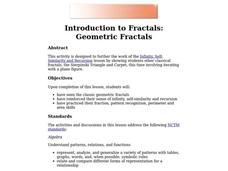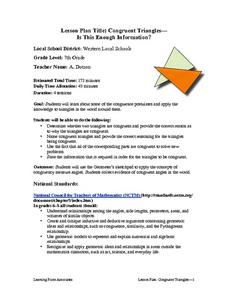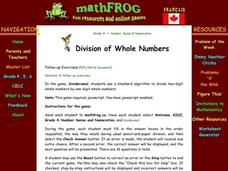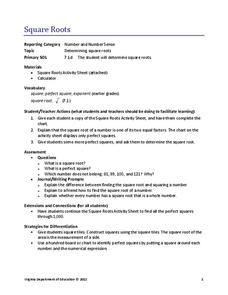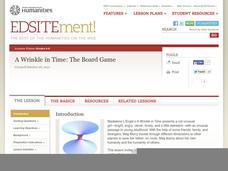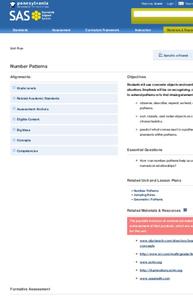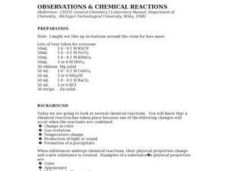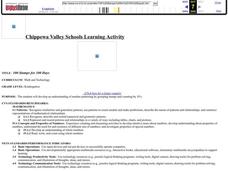Curated OER
Volume and Surface Area: Which Is More?
Students explore the volume and surface area of three dimensional figures. Through the use of video, students discover three dimensional shapes, their uses in real-life applications, and methods used to calculate their volume and surface...
Curated OER
Introduction to Fractals: Geometric Fractals
Learners study and observe the patterns made by the areas of the Sierpinski Triangle. Students use the computer to draw two or three iterations to discover the number patterns. Learners complete worksheets based on Geometric Fractals.
Curated OER
Bag the Beans
Students are exposed to a wide array of concrete representations to help develop a foundation for the higher abstract ideas associated with mathematical inquiry. In this instructional activity, students will work with manipulatives...
Curated OER
A Meal of Endurance
Students evaluate the nutritional value of the explorers' meals. This is done through analyzing caloric intake versus caloric expenditure, describing the trend in diet change that explorers experienced over a two year expedition, ...
Curated OER
Congruent Trianges - Is This Enough Information?
Seventh graders determine whether two triangles are congruent and provide an explanation to why they are not. They apply concepts of measurement of angles and collect evidence of congruent angles in the world.
Curated OER
The Golden Ratio
Seventh graders investigate a ratio found in nature and in numerous pieces of artwork throughout history. The lesson is cross-curricular and builds a sense of appreciation of design for students.
Curated OER
Tower of Hanoi Lesson Plan
Students investigate the Legend of the Tower of Hanoi and complete mathematical problems related to the legend. They play the Tower of Hanoi game online in order to discover the number pattern involved. They solve problems using the...
Curated OER
Division of Whole Numbers
Students divide two-digit numbers by one-digit whole numbers. Using a specified website, they play complete standard division algorithms. Students receive immediate feedback on the website. In addition, they complete problems on paper.
Curated OER
Order of Operations
Sixth graders, while in the computer lab, participate in the Order of Operations game where they must complete as many questions involving two operations as possible in 120 seconds. They review the summary of his/her performance when it...
Virginia Department of Education
Square Roots
Square away any doubts about using a new resource. Pupils learn about squares and square roots in the mini-lesson. They complete a worksheet identifying roots of perfect squares up to 400.
National Endowment for the Humanities
A Wrinkle in Time: The Board Game
Tackle some big questions about A Wrinkle in Time by Madeleine L'Engle with a board game project. As learners brainstorm for and complete their board games, they consider what helps and hinders Meg on her journey and why she succeeds in...
University of Nottingham
Drawing to Scale: A Garden
See how design and geometry go hand in hand. The activity asks learners to use geometry to design a backyard garden given dimensions of each feature. Scholars work with ratios and scale to develop an accurate scale drawing that includes...
Polar Trec
Global Snow Cover Changes
Snow is actually translucent, reflecting light off its surface which creates its white appearance. Pairs or individuals access the given website and answer questions about snow cover. They analyze graphs and charts, examine data, and...
Curated OER
Fraction Models
Third graders make models of fractions and mixed numbers. Using fraction strips and drawing pictures, 3rd graders develop conceptual understanding of the equivalent forms. Students use the number line to represent and compare...
Curated OER
Number Patterns
First graders use manipulatives to complete and extend patterns. In this patterns lesson, 1st graders complete a pattern with a missing element, extend a pattern, and sort objects by characteristics.
Curated OER
Patterns
Second graders create an ABAB pattern with their name. For this early elementary math lesson, 2nd graders first model their names in an ABAB pattern with unifix cubes. They then recreate the pattern using letter stamps on KidPix.
Curated OER
Veggie Chop and Data Analysis
First graders chop vegetables into fractions. In this fractions lesson, 1st graders cut vegetables, collect data about favorite vegetables and create a bar graph using the information. Students make inferences about the data and...
Curated OER
Basic Sense
Fifth graders add fractions. After a class discussion on real life application of fractions, the teacher uses fractions strips to model adding fractions. In pairs, 5th graders model adding fractions by drawing diagrams. They justify...
Curated OER
Time and Earth History Socratic Questions
Students develop a sense of geologic ("deep") time and the ways in which Earth scientists construct the geologic time scale. They study he major events that shaped Earth, including the origin and evolution of its lithosphere, atmosphere,...
Curated OER
Discovering Shoes, Step by Step
Learners discuss and write about their interpretations of the art. They compare and contrast the numerous types of shoes and how they are used in a certain time and place. Students memorize the Shel Silverstein's poem, "Ickle Me, Pickle...
Curated OER
Name Games
Students develop a sense of self. They complete several activities involving their name. They disuss what names are useful for safety purposes.
Curated OER
Observations & Chemical Reactions
Students conduct a series of experiments in which they explore chemical reactions. They detect chemical changes by observing how physical properties change when two different chemicals are combined. They list and describe the reactants...
Curated OER
How Much is a Name Worth?
Second graders listen to a read aloud of Yangsook Choi's, The Name Jar. First, they estimate how much their name is worth based on the teacher's example. They assign numeric values to the letters of the alphabet in order to compute the...
Curated OER
100 Stamps for 100 Days
Students recognize similarities and generalize patterns. In this math and technology lesson plan, students develop an understanding of number patterning by grouping stamps and counting by 10s.

